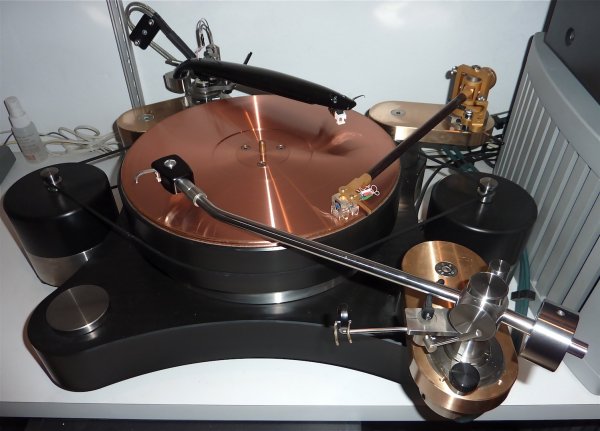It does have two 150w amplifiers though!
I wouldn't place too much faith in this translation, ask the manufacturer exactly how they control the speed of their 'amplifiers'!
Keith.
Here's an excerpt from the Saskia sheet that describes how we do it. To expound on that, the speed is maintained by a time based method, rather than a frequency based one. It gently "nudges" the speed back to the target whenever the sensor detects inaccuracy, rather than making a single abrupt correction, but when it senses a major change like the user's hand stopping the platter, it lets the motor bring the speed back without any help from feedback. Corrections are infrequent because the speed can stay on target for long periods of time without any correction at all, so it is usually just monitoring the operation. If correction is needed, the controller nudges the platter back into position with several spaced out nudges that are very small. Any changes that it does make are not ones you can see with a Sutherland Timeline. In fact, the dot made by a Timeline won't ever move a noticeable amount. It is a "less is more" approach. There's even the option for the user to never use the feedback feature at all.
Saskia model two turntable
Motor Management Features:
3-phase AC power generation
The controller's main purpose is to convert commonly available single-phase power to Saskia’s 3-phase hysteresis eddy current motor. Traditionally, 3-phase AC motors have been adapted for use in single-phase turntables by using an arrangement referred to as a “faking capacitor”. However, these motors always run quieter and more smoothly when used with a proper 3-phase power source. Saskia is designed from the start to take full advantage of its benefits.
60MHz 32-bit Microprocessor
The controller's signal generation and user interface is managed by a 32-bit processor and custom DSP software. To our knowledge, this is the most powerful processor being used in a turntable product.
All frequencies are accurate to within 0.001%
All signals generated by the controller are derived from a precision 10 ppm quartz oscillator.
Power synthesis using high-precision DACs
The AC waveforms are generated using the highest quality precision 16-bit Digital-to-Analog converters from Analog Devices, Inc.
Designed for long-term reliability
Heavy-duty linear power supplies with premium components, twelve high-current MOSFET devices and a large heat sink are employed for maximum fault-tolerance and reliability. No switch-mode devices are used.
Continuously variable control of AC frequency and amplitude
Instead of being a fixed power source, the controller and its software are capable of delivering power that is custom tailored to the task of powering Saskia. Power delivered to the motor is gradually increased as the platter comes up to speed, allowing a smooth, on-the-fly transition between playback speeds. This eliminates slippage and chatter, and greatly reduces drive component wear.
Optical feedback system
Environmental factors, self-heating (warm up), and age can all have an effect on a turntable's rotational accuracy. The Saskia model two features a non-contact rotation sensor under its platter and an optional feedback system to keep the platter locked precisely at the desired speed. The system’s adaptive algorithm is designed with a long time constant to avoid the overshoot and 'hunting' problems often associated with less well designed active speed controls.
High contrast OLED display
The control interface uses a white OLED (Organic Light Emitting Diode) display. This display can be clearly seen at any angle, unlike a traditional LCD display.
Touch sensitive control input buttons on front panel
Operation of the controller interface is performed using four touch sensitive stainless steel buttons located around the OLED display which shows the current function of each button.
Removable power cord and rocker power switch on back panel
A high-quality Tel Wire power cord is included with Saskia, but any standard 3-conductor cord may be used. Power can be switched off (disconnecting both HOT and NEUTRAL) where it enters the controller, if the turntable will not be used for an extended period of time.
Intelligent operational and safety monitoring
The controller software constantly monitors many data points including incoming AC power quality, internal temperature, and motor current. A detected fault will safely shut down the turntable . An internal fuse is also provided.
User-upgradeable Firmware
The controller features a USB port to allow the firmware to be easily upgraded at any time using a standard thumb drive. Saskia Turntables will notify its customers whenever an upgrade is available.
Rugged and highly serviceable design
The Saskia model two controller is hand built from carefully selected, high quality components. Robust fault detection, modular design, and the use of high quality connectors throughout make it easier to service than most other modern electronic devices, should the need ever arise.








